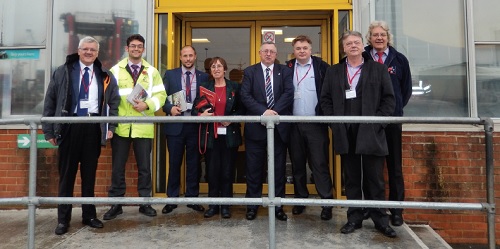Management staff from Britannia Leatherbarrows of Bournemouth and Andover, Britannia Robbins of Swansea and Britannia Freestones were invited as guests of DP World to visit the upgraded container port at Southampton to be briefed on the facilities now available to assist their customers in moving abroad.

The port of Southampton has had some very serious investment and not only can the container terminal handle cargo from the largest vessels now sailing, up to 18,000 TEUs, but the rail connection has been vastly improved and a significant number of containers are moved daily on over 30 freight trains running out of the freightliner terminal immediately adjacent.
The team led by Leatherbarrows MD, Robert Dance, were able to see all four of the container berths not only occupied, but all dockside cranes working to move loaded containers bound for the UK from each of the vessels and see export containers together with empty containers being loaded for destinations on each vessels route.
The scale of cargo handling is incredibly efficient and when a vessel is alongside there is 24/7 working to minimise lost sailing time. Each crane is serviced by three straddle carriers which bring containers forward to load and remove unloaded containers. There is a constant update of electronic information recording every movement and at all times the GPS location of every container is known.
There was a discussion about the new regulations being introduced in 2016 which will require shippers to declare the actual weight of containers and cargo being presented for shipping and how this need was to be monitored and checked. Clearly the Britannia Team were expecting the terminals to arrange to check the total weight when the containers were lifted from the road or rail truck on arrival at the port, but as yet no plans to put this facility in place were finalised.
The team found on visiting the cargo planning area that both weight and final destination were vital factors when the planers organised how the ship was stacked to minimise the number of times containers had to be moved whilst the vessels carried out their circular routes around the world. Lighter containers on the outside and on the top and heavier containers in the centre and low down were essential to keep the cargo as safe as possible.
One of the Union Representatives described the skills in crane driving and handling and working the straddle carriers. He outlined how the key performance indicators had been established and how the teams working a crane were encouraged to be accurate yet fast and efficient to keep the terminal active, earn bonuses and keep the ships moving on time.
The port had been free of any conflict between workforce and management for a significant number of years and he paid tribute to the transparency methods from the Terminal Director downwards which contributed hugely to this, as well as the flexibility offered by both workforce and the management team of the terminal.
It was explained that the terminal’s objective is to turn every road vehicle round within one hour and for drivers to be given a timed slot to enter the port. Packing crews could therefore organise loading and unloading of containers at customers’ homes with confidence that times would be met.
All the Britannia Movers International visitors left the port extremely impressed with how the industry had coped with the pressures of modern day container handling and the introduction of larger vessels and electronic information exchange.
Photo: (Left to right): Geoff Robbins; Lewis Mills, Commercial Manager Leatherbarrows; Richard Fisher, General Manager Leatherbarrows; Jenny Horner, International Sales Leatherbarrows; Robert Freeman; Robin Johnston, Andover Manager Leatherbarrows; David Freestone and Rob Dance.